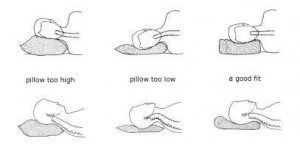Ask the Docs

Avoid These Neck Damaging Activities if You Want to Get Better
By Dr. Jonathon Chung of Keystone Chiropractic
Everyday I take care of patients that get fast and substantial relief from neck related conditions like neck pain, arm pain, and headaches.
When they get better, they’ll often go months without any problems before a seemingly harmless activity seems to make the pain return.
There are a lot of myths and half-truths about the causes of neck pain. Before we tackle what actually can cause neck problems, let’s talk about some of the myths.
Myths
- “I have text neck” – there’s a lot of buzz about the concept of “text neck”. The problem is that it’s really a half-truth, you’ll see the real reason why electronic devices are causing problems down below.. For an in depth read about this, check out this article on my blog.
- “I Can’t Exercise Because I have a Military Neck and Bulging Discs” – Another major misconception. Way too many people have these issues and have no pain at all. Military Necks and Bulging Discs are not likely the CAUSE of your neck pain.
- “I Should Rest My Neck Until It Stops Hurting”- Resting the neck may be a good short term solution, but if you are habitually sedentary or avoiding movement because of your neck it may be causing more problems in the future.
Activities That Can Aggravate the Neck
- Even “Perfect Posture” for Hours Can Hurt
Any posture that you hold for hours straight can cause neck pain, even so-called “perfect posture”. Posture is not the problem here; lack of motion. This is where text-neck got so much traction. People spending hours on a phone or laptop can cause pain in the neck, but it’s not just a forward slouched position of text-neck. It’s because people use their electronic devices for hours without moving.It’s not a specific posture that causes pain most of the time, it’s a lack of regular motion that can lead to the increased perception of pain.The moral of the story: Take the time to get up and move frequently. - Excessive Head Movement Under Load
What’s one of the worst things you can do in the gym? It’s to create excessive shearing force of your joints while under a load. This is true for the neck, back, knees, and almost every other joint in the body.Imagine holding this weight on your head: Would you even consider turning or bending your neck with hundreds of pounds coming down on your head?Of course not. It will create a grinding/shearing force that can wreck the soft tissues of your neck.
Would you even consider turning or bending your neck with hundreds of pounds coming down on your head?Of course not. It will create a grinding/shearing force that can wreck the soft tissues of your neck.
The same is true for weight lifting. Whether you are squatting, pressing, dead-lifting, or doing pull ups, you can create excessive shearing force by moving your neck while under a load.
Keep your neck (and your whole spine for that matter) in a controlled neutral position for the short duration that you are performing exercise reps.
- Work Related Chronic Repetitive Movements
A lot of the baby boomer generation are familiar with the pain and injuries from working on an assembly line.The constant repetitive motion has long been associated with wear and tear on the muscles and joints of the body. Decades of boomer elbows, shoulders, and hands can attest to this.When it comes to the neck in today’s generation, we see a lot of these problems arise in professions like dental hygienist, dentists, surgeons, and people working with small electronic parts.When the neck is chronically flexed for hours for work, the neck becomes more exposed to strain. - Bad or repeated self-manipulation
Do you love to crack your own neck? It feels so good to make your joints pop and get that temporary feeling of looseness!However, you might be setting yourself up for chronic neck hypermobility. I’ve seen it hundreds of times in chiropractic school where constant cervical spine manipulations on each other lead to students feeling sick and chronically stiff.While their neck has been loosened by repetitive manipulation, the soft tissues of the neck became disrupted to the point where they felt they needed constant adjustments.Taking care of people after they’ve had poor manipulation or were over-manipulated are sometimes the most challenging patients to get long term stability.You can read more on my most popular blog post here if you have not already done so.
- Stomach sleeping and poor pillow height People always want to know what the best bed or pillow is, but a lot of times it’s your positioning that matters, not the substance.Stomach sleeping is associated with increased episodes of neck and back pain while side sleeping and back sleeping tend to be protective.Pillow height is also important depending on your sleeping position.
- Side sleepers will fare better with pillows that are just smaller than the distance between your neck and tip of the shoulder.
- Back sleepers will want a pillow that reflects the distance between the back of the head and the base of the neck. If you have a small distance between your ear and shoulder, you will want a flatter pillow, but if you have a large distance between your ear and shoulder, you will want a pillow a little higher.
See the image below:

Take all of this into account when considering ways to protect your neck from aggravation.
These small little steps can help make sure that the episodes and intensity of neck pain continue to decline as your body heals and repairs.
What are your triggers?
What other things have you noticed bring out head and neck issues? With a little knowledge of neck bio-mechanics, we may be able to help address the causes of your neck dysfunction.
***
Did you like this article? Feel free to share it with the people you care about and see if a Complimentary Consultation is the next step to regain their health.
Dr. Chung is a practicing Structural Chiropractor in the West Palm Beach area. He has been published in peer reviewed scientific journals and is a sought after speaker in health and wellness. Follow his blog at http://chiropractorwellington.com/category/keystone-chiropractic-blog/ or find him on twitter at @drjonathanchung.

